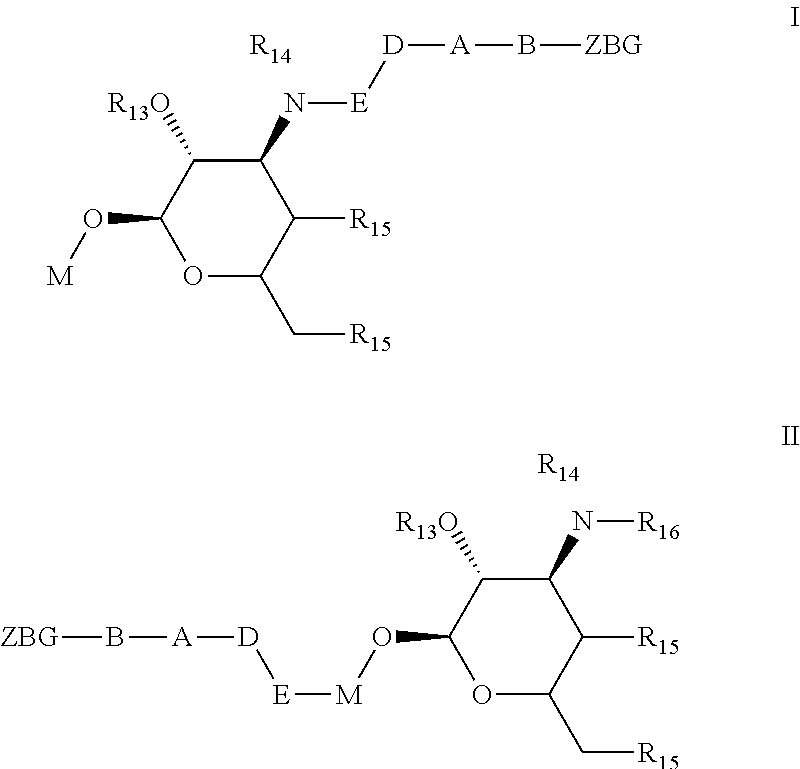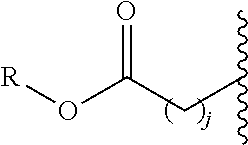Non-peptide macrocyclic histone deacetylase (HDAC) inhibitors and methods of making and using thereof
a histone deacetylase and non-peptide technology, applied in the field of hdac inhibitors and methods of making, can solve the problems of poor oral bioavailability, lack of clinically effective cyclic-peptide hdac inhibitors, and wide application in specific therapies, such as cancer therapy
- Summary
- Abstract
- Description
- Claims
- Application Information
AI Technical Summary
Benefits of technology
Problems solved by technology
Method used
Image
Examples
example 1
Synthesis of Compounds 7-14 and 23-30 in Table 3
Synthesis of Azithromycin-N-phenylacetylene (3)
[0162]To a solution of N-demethylated azithromycin 1 (2.0 g, 2.56 mmol) in anhydrous DMSO (30 ml) was added Hunig's base (4 ml) and 4-ethynylbenzyl methanesulfonate 2 (0.760 g, 3.60 mmol). The reaction mixture was heated with stirring under argon at 85° C. for 2.5 h. The reaction was cooled and diluted with ethyl acetate (EtOAc, 100 mL) and washed with saturated NaHCO3 (3×60 mL) and saturated brine (60 mL). The organic layer was dried over Na2SO4 and concentrated in vacuo. The crude product was purified by flash chromatography (silica, 12:1:0.05 CH2Cl2 / MeOH / conc. NH4OH) to give 1.2 g (52%) of 3 as a brownish white solid. 1H-NMR (CDCl3, 400 MHz) δ 0.84 (m), 0.97 (d, J=7.6 Hz), 1.04 (m), 1.12-1.32 (m), 1.36-1.53 (m), 1.66-1.75 (m), 1.81-2.07 (m), 2.19 (s), 2.25-2.29 (m), 2.48 (m), 2.63-2.73 (m), 2.89 (bs), 2.96 (1, J=9.8 Hz), 3.02 (s), 3.08 (s), 3.27-3.32 (m), 3.38-3.45 (m), 3.56 (d, J=6.8 ...
example 2
Synthesis of Compounds 36 and 38 in Table 3
Synthesis of Methyl 8-(4-(hydroxymethyl)phenylamino)-8-oxooctanoate (33)
[0197]To a mixture of 8-methoxy-8-oxooctanoic acid (0.40 g, 2.10 mmol), benzotriazole (0.28 g, 2.23 mmol) in anhydrous CH2Cl2 (15 mL) was added SOCl2 (0.17 mL, 2.23 mmol) at 0° C., the mixture was kept stirring at 0° C. for 2.5 h and then filtered. The solvent was evaporated off to give crude acid chloride 31 which was used without further purification.
[0198]To a solution of (4-aminophenyl)methanol 32 (0.31 g, 2.50 mmol) in anhydrous pyridine (8 mL) was added chlorotrimethylsilane (0.32 mL, 2.50 mmol) at room temperature and stirring continued for 2 h. The mixture, together with a catalytic amount of DMAP, was added to a mixture of crude chloride 31 (obtained as described above) in pyridine at 0° C. The reaction was allowed to warm to room temperature and stirring continued overnight. Water (5 mL) and 1 M TBAF in tetrahydrofuran (THF) (0.25 mL, 0.25 mmol) were added and...
example 3
Synthesis of Compounds 40, 44 and 47 in Table 3
Synthesis of Azithromycin-N-phenyltriazolylhepta-2-methyl ketone (40)
[0204]Compound 3 (0.040 g, 0.047 mmol) and azido-2-methyl ketone 39 (0.011g, 0.071 mmol) were dissolved in anhydrous THF (7 mL) and stirred under argon at room temperature. Copper (I) iodide (0.010 g, 0.053 mmol) and Hunigs' base (0.1 mL) were then added to reaction mixture and stirring continued for 2 h. The reaction mixture was diluted with CH2Cl2 (40 mL) and washed with 1:4 NH4OH / saturated NH4Cl (3×30 mL) and saturated NH4Cl (30 mL). The organic layer was dried over Na2SO4 and concentrated in vacua. The crude product was purified by preparative TLC (12:1 CH2Cl2:MeOH) to give 38 mg (81%) of 40 as a white solid. 1H NMR (CDCl3, 400 MHz) δ 0.86-0.89 (t, J=7.2 Hz), 0.92-0.98 (m), 1.01-1.02 (d, J=7.2 Hz), 1.086 (s), 1.12-1.24 (m), 1.29-1.34 (m), 1.42-1.66 (m), 1.74-1.78 (d, J=16 Hz), 1.84-2.08 (m), 2.11 (s), 2.15 (m), 2.26-2.48 (m), 2.56-2.74 (m), 2.84 (s), 2.74-3.08 (m)...
PUM
| Property | Measurement | Unit |
|---|---|---|
| Structure | aaaaa | aaaaa |
Abstract
Description
Claims
Application Information
 Login to View More
Login to View More - R&D
- Intellectual Property
- Life Sciences
- Materials
- Tech Scout
- Unparalleled Data Quality
- Higher Quality Content
- 60% Fewer Hallucinations
Browse by: Latest US Patents, China's latest patents, Technical Efficacy Thesaurus, Application Domain, Technology Topic, Popular Technical Reports.
© 2025 PatSnap. All rights reserved.Legal|Privacy policy|Modern Slavery Act Transparency Statement|Sitemap|About US| Contact US: help@patsnap.com



